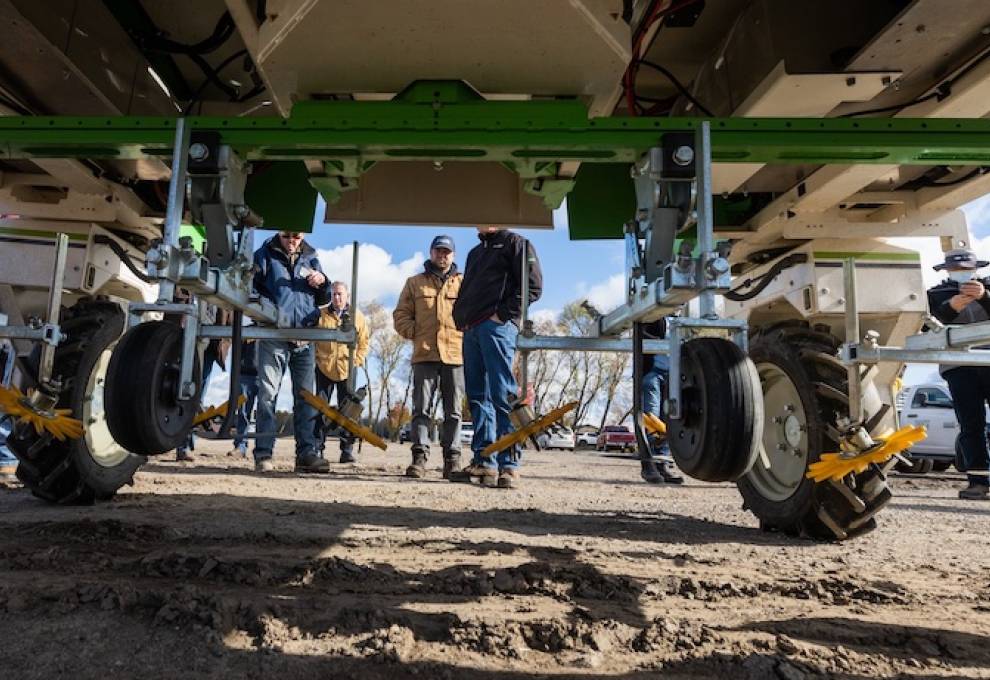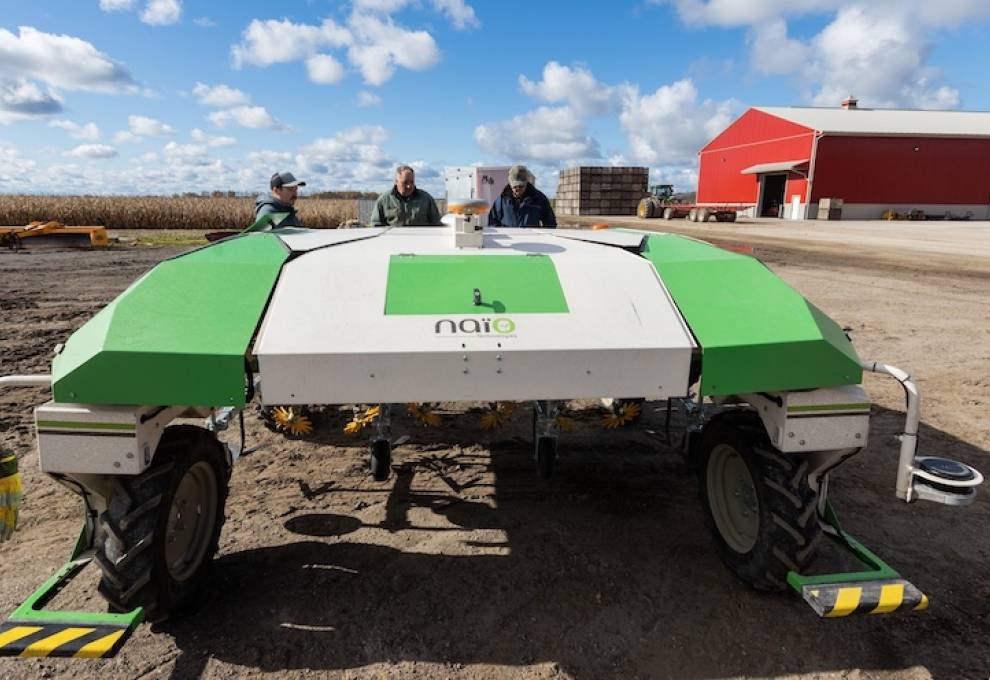

Doug meets Dino.
“How smart do I need to be to operate this smart equipment?” It’s one of the questions posed – with a poke-in-the-ribs laugh -- when growers are kicking the tires of a machine that looks more suited to a moon walk.
Doug Van Luyk is not alone. The Newmarket, Ontario grower is curious yet skeptical about how a robotic weeder could solve the issue of resistant pigweed in his root vegetables on muck soils. He looks at Dino and wonders if a worker would be needed to supervise the robot.
His doubts are confirmed by Dr. Mary Ruth McDonald, professor, University of Guelph and research program director, Ontario Crops Research Centre. She’s been providing input to some of the robotic developers for the past few years.
“Yes, you need more highly trained personnel to operate the robot,” says McDonald. “We’re in the early stages of these robots. Think of a model T. In 10 years, I think they will be much more effective.”
Personnel need to be trained in the use of the cultivation tools. Typically, the human tractor operator can make those adjustments while they are operating, but since the robot has no operator, they need to be using a tablet or other computer interface ahead of time. This generally requires a different skill set as compared to a tractor driver.
Trends
Dino is one of more than 250 robots worldwide manufactured by Naïo Technologies. Pronounced NI-OH, the company is based in Toulouse France where engineers have worked for a decade to perfect the robotics. In late 2021, the company announced that its autonomous robots are certified under European law to work unsupervised as of 2022. Two major risks have been overcome: colliding with a person and exiting an authorized area onto a road.
As the Naïo company’s news release explains, “The farmer creates a map of each field the robot needs to weed using its GPS system, uploads it into Dino through a USB key, puts the robot in front of the first field and Dino does the rest.”
That’s a simplistic description as many variables affect performance such as soil density, crop type, weed size and access to recharging stations. The Dino can operate for between six and eight hours, depending on soil conditions and how many of the machine’s tools are in use at one time. The batteries require about eight hours to recharge, but Naïo’s engineers are working on speeding up the recharging time.
Opportunities
McDonald points out that Canadian company Nexus Robotics is working on a hybrid model now called La Chèvre (The Goat) that is operated by hybrid diesel-electric power.
Teric Greenan, COO, Nexus Robotics, agrees that his prototype is a much more ambitious model. “When it works, it will be the best way of removing weeds without hurting the plant.”
The bigger opportunity will be for the robot to do more than one function, such as thinning lettuce. This is a much more complicated feat of engineering requiring more dexterity.”
La Chèvre is an active weeder, using artificial intelligence and computer vision to identify the weed. When these functions are perfected, Greenan hopes that the photos can be downloaded and that the robot can be trained to distinguish different kinds of weeds or even disease. In this sense, the robot would have the dual role of weeder and of crop scout.
One of the hurdles to overcome, says McDonald, is that changing light patterns affect the quality of the photos which impacts the correct identification of weeds versus plants. Carrots are an easy crop to test pilot because the foliage is so different from the weeds. But complexity is increased in a crop such as celery.
Originally based in Nova Scotia, Nexus Robotics has now moved to Montreal to be in closer proximity to the vegetable growing regions of Québec and Ontario. Greenan is looking forward to the 2022 growing season, working with Chuck Baresich, Haggerty Creek Inc, a precision agriculture company in Bothwell, Ontario who represents the Dino robot.
Together, they will have boots on the ground for research and demonstrations. Baresich reports that the Dino will be deployed on a fee-for-service basis in two commercial operations. One will be in root crops in the Holland Marsh, Bradford and another in Brussels sprouts near Chatham, Ontario.
The growers are looking to reduce or eliminate the need for a roving weeding crew with Dino which will operate over six weeks on 50 acres. That’s 10 acres per day.
A third company, based out of Denmark, will be sending a solar-powered FarmDroid to be tested under Ontario conditions (www.FarmDroid.dk/en). The company’s website says it’s the first robot to seed and weed in a C02-neutral and ecological way.
Chuck Baresich anticipates that all three robots will be scheduled for public demonstrations likely in April, July and September 2022.
Future issues
“I see robotics as a future for Ontario agriculture,” says Kristen Obeid, weed management specialist, Ontario Ministry of Agriculture, Food and Rural Affairs (OMAFRA). She’s chair of an Ag Robotics Working Group (WG) whose mandate is to conduct on-farm demonstrations to “ground truth” the technology, build networks and brainstorm about the technologies.
The working group includes OMAFRA, university researchers and grower associations. Agribusiness and robotics companies, who are also members, are impressed with Ontario’s infrastructure and the diversity of agricultural production within short distances. They see the potential to create an Ag Robotics Hub or Network.
“There is just so much opportunity for robotics in the ag space, but we need to seize all opportunities now so we are not left behind,” she says.
Naïo’s Dino and Oz robotic weeders, Nexus Robotics’ La Chèvre and Korechi Innovations RoamIO were demonstrated at several field days in 2021. GPS signals could be inhibited in fields that were protected by forest or windbreaks on multiple sides.
Access to the internet is required for safety and remote monitoring. That means rural internet service needs to improve to accommodate the wave of technology that could ease labour issues.
This may be the decade for Dino. While he’s a teenager now, he’ll be an adult by 2030. And perhaps by then, he’ll be on the payroll.

Add new comment